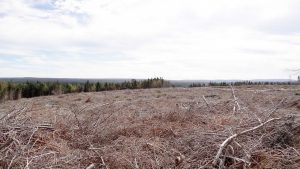
Even in Protected Areas: Clearcut in lands designated for the Raven Head Protected Area, 2011 (“To negotiate a price within the province’s budget, Wagner Forestry [was] allowed to harvest about one quarter of the Apple Head area”)
I had to remind myself that I wasn’t trespassing, that in fact this was my land, and yours, which these harvesters are only now borrowing. With that context I can be forgiven for my turmoil, developing, as it did, the deeper into this devastation I dared trek.
I didn’t come here to see the clearcut.In fact I was in pursuit of a species at risk when I came upon the remains of its habitat. This was the largest cut I’ve ever heard tell of, its expanse of dried out dirt, discarded branches and multitudes of stumps seeming to go on forever.
…From the hard, hot tangle of dead branches and stumps I stepped into the uncut trees which now formed islands of green in a sea of sun-bleached white, the ground within their borders squishy with moisture and masses of healthy peat.
The air was immediately cooler and bird songs rang true through the pillars of fir and spruce. Then there was the stream, meandering downhill with serenity in the presence of such ubiquitous destruction…
It’s the Nova Scotia landscapes we don’t talk about in those TV ads, but that are now hard to avoid when you come to Nova Scotia.
A National Geographic film crew flew to the Halifax airport several years ago, hired a vehicle and drove to my place east of Antigonish. These world travellers came to discuss coyotes, but the cameraman’s first question was: “What’s wrong with your forests? They’re scruffy and scrawny.”
– Bob Bancroft in Seed trees determine future of N.S. forests (CH Dec 14, 2013)
So what do we tell the vistors who want to see our forests, NSDNR? That about 10% is protected, to go there along with the Clearcut Refugees?
————
Tip of the hat to AM for passing this along.
Thanks, Zak Metcalfe, for writing from both the heart and the brain.
